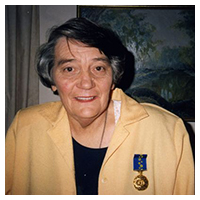 My sister, Helen Walker was diagnosed in 1990 with Pompe’s Disease. Little was known about this rare disease in Australia at that time. One morning Helen serendipitously happened to watch a TV interview with Professor John Hopwood on the research his group in Adelaide was doing on Glycogen Storage Diseases. She rang him the next day and had a long conversation. His interest in her situation resulted in a firm professional friendship between them. He informed her of his connections with the scientific work developing therapies at Erasmus University and at Sophia Children’s Hospital in Rotterdam.
My sister, Helen Walker was diagnosed in 1990 with Pompe’s Disease. Little was known about this rare disease in Australia at that time. One morning Helen serendipitously happened to watch a TV interview with Professor John Hopwood on the research his group in Adelaide was doing on Glycogen Storage Diseases. She rang him the next day and had a long conversation. His interest in her situation resulted in a firm professional friendship between them. He informed her of his connections with the scientific work developing therapies at Erasmus University and at Sophia Children’s Hospital in Rotterdam.
John also arranged contact with three other known Pompe patients in Australia: Together they formed the Australian Pompes Association with Helen as President.
Through the Australian Diagnostic Service for Pompes Disease in Adelaide, Helen was able to inform managing physicians of the existence of the Association as new diagnoses were confirmed. Doctors were requested to inform their patients of the existence of the APA. And so the organisation grew in membership.
Helen’s gratitude and respect for John Hopwood and the research team in Adelaide was never forgotten. She owed so much for the success of her endeavours to this dedicated group and as a consequence she left a substantial amount from her estate to the South Australian Health and Medical Research Institute for future research.
 I first met Professor Hopwood at Helen’s funeral in November 2012. John flew to Melbourne to speak at her funeral. Earlier this year he rang me to announce his imminent retirement and his wish to launch a memorial benevolent fund in honour of Helen at The Institute. He invited me to attend the launch and to speak. On May 10 this year I attended SAHMRI’s launch of the beneficiary fund called ‘The Walker Society’.
I first met Professor Hopwood at Helen’s funeral in November 2012. John flew to Melbourne to speak at her funeral. Earlier this year he rang me to announce his imminent retirement and his wish to launch a memorial benevolent fund in honour of Helen at The Institute. He invited me to attend the launch and to speak. On May 10 this year I attended SAHMRI’s launch of the beneficiary fund called ‘The Walker Society’.
The establishment of the South Australian Health and Medical Research Institute (SAHMRI) began in 2007 when the South Australian Government commissioned the Review of Health and Medical Research in South Australia which recommended the establishment of a dedicated research institute for South Australia.
In response to this recommendation, the South Australian Government committed to establish SAHMRI in 2008, and the Federal Government allocated $200 million to build the research facility. In December 2009, SAHMRI was incorporated as the state’s first independent health and medical research institute.
